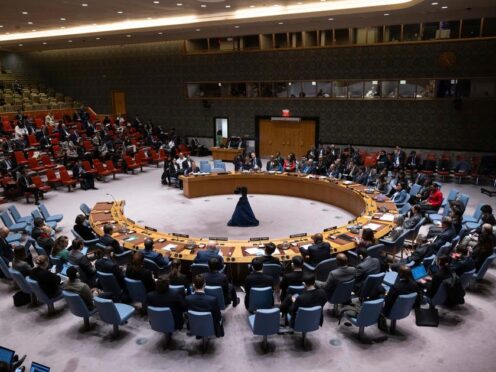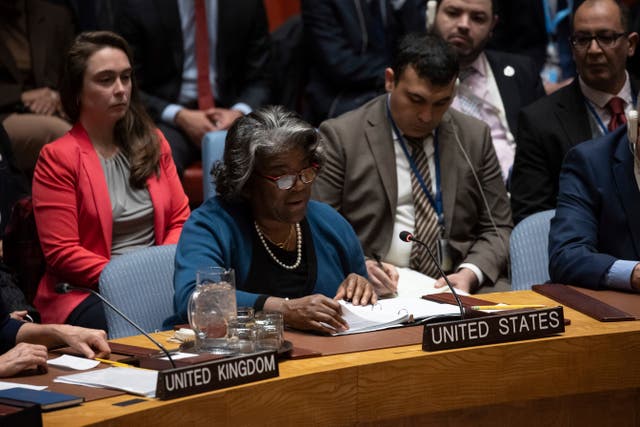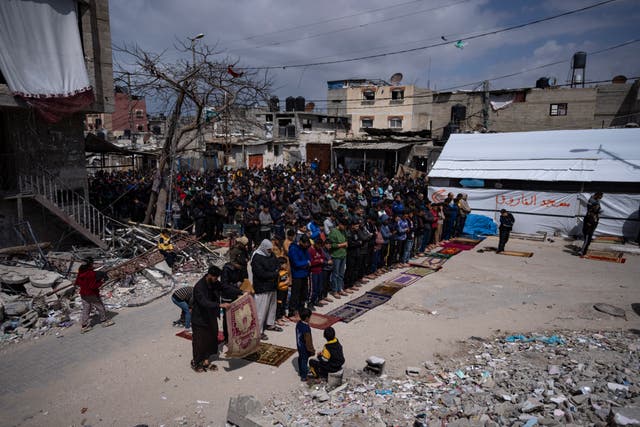
Russia and China have vetoed a US-sponsored UN resolution calling for “an immediate and sustained ceasefire” in the Israel-Hamas war in Gaza to protect civilians and enable humanitarian aid to be delivered to more than two million Palestinians.
The vote in the 15-member Security Council was 11 members in favour and three against, including Algeria, the Arab representative on the council.
There was one abstention, from Guyana.
Before the vote, Russian UN ambassador Vassily Nebenzia said Moscow supports an immediate ceasefire, but he criticised diluted language that referred to moral imperatives, which he called philosophical wording that does not belong in a UN resolution.
He accused US secretary of state Antony Blinken and US ambassador Linda Thomas-Greenfield of “deliberately misleading the international community”.
“This was some kind of an empty rhetorical exercise,” Mr Nebenzia said.
“The American product is exceedingly politicised, the sole purpose of which is to help to play to the voters, to throw them a bone in the form of some kind of a mention of a ceasefire in Gaza… and to ensure the impunity of Israel, whose crimes in the draft are not even assessed.”
China’s UN ambassador, Zhang Jun, said the US proposal did not promote an immediate and sustained ceasefire, set preconditions and fell far short of expectations of council members and the broader international community.
“If the US was serious about a ceasefire, it wouldn’t have vetoed time and again multiple council resolutions,” he said.
“It wouldn’t have taken such a detour and played a game of words while being ambiguous and evasive on critical issues.”
Ms Thomas-Greenfield urged the council to adopt the resolution to press for an immediate ceasefire and the release of the hostages, as well as to address Gaza’s humanitarian crisis and support ongoing diplomacy by the United States, Egypt and Qatar.
After the vote, Ms Thomas-Greenfield accused Russia and China of voting for “deeply cynical reasons”, saying they could not bring themselves to condemn Hamas’s terrorist attacks in southern Israel on October 7, which the resolution would have done for the first time.

A key issue in the vote was the unusual language related to a ceasefire.
It said the Security Council “determines the imperative of an immediate and sustained ceasefire” – not a straight-forward “demand” or “call”.
The resolution did reflect a shift by the United States, which has found itself at odds with much of the world as even close allies push for an unconditional end to fighting.
In previous resolutions, the US has closely intertwined calls for a ceasefire with demands for the release of Israeli hostages in Gaza.
This resolution, through awkward wording that is open to interpretation, continued to link the two issues, but not as firmly.
While the resolution would have been officially binding under international law, it would not have ended the fighting or led to the release of hostages.
But it would have added to the pressure on Israel as its closest ally falls more in line with global demands for a ceasefire at a time of rising tensions between the US and Israeli governments.
Meanwhile, the 10 elected members of the Security Council have put their own resolution in a final form to be voted on.
It demands an immediate humanitarian ceasefire for the Muslim holy month of Ramadan that began on March 10 to be “respected by all parties leading to a permanent sustainable ceasefire”.
Riyad Mansour, the Palestinian UN ambassador, told reporters the vote would take place either late on Friday or on Saturday morning.

The resolution also demands “the immediate and unconditional release of all hostages” and emphasises the urgent need to protect civilians and deliver humanitarian aid throughout the Gaza Strip.
Mr Nebenzia urged council members to support it, but Ms Thomas-Greenfield said the text’s current form “fails to support sensitive diplomacy in the region. Worse, it could actually give Hamas an excuse to walk away from the deal on the table”.
The Security Council had already adopted two resolutions on the worsening humanitarian situation in Gaza, but none has called for a ceasefire.
Russia and China vetoed a US-sponsored resolution in late October calling for pauses in the fighting to deliver aid, protection of civilians and a halt to arming Hamas.
They said it did not reflect global calls for a ceasefire.
The US has vetoed three resolutions demanding a ceasefire, the most recent an Arab-backed measure supported by 13 council members with one abstention on February 20.
A day earlier, the US circulated a rival resolution, which went through major changes during negotiations before Friday’s vote.
It initially would have supported a temporary ceasefire linked to the release of all hostages, and the previous draft would have supported international efforts for a ceasefire as part of a hostage deal.
Security Council members fail to adopt resolution stating the imperative of an immediate & sustained ceasefire in Gaza.
As conditions on the ground continue to worsen & famine looms, the UN keeps seeking ways for safe humanitarian access to save lives. https://t.co/nIQELFxb6M pic.twitter.com/vKOxFoouPO
— United Nations (@UN) March 22, 2024
The vote took place as Mr Blinken, America’s top diplomat, is on his sixth urgent mission to the Middle East since the Israel-Hamas war, discussing a deal for a ceasefire and hostage release, as well as post-war scenarios.
Palestinian militants killed some 1,200 people in the surprise October 7 attack into southern Israel that triggered the war, and abducted another 250 people.
Hamas is still believed to be holding some 100 people hostage, as well as the remains of 30 others.
In Gaza, the Health Ministry raised the death toll in the territory on Thursday to nearly 32,000 Palestinians.
The agency does not differentiate between civilians and combatants in its count but says women and children make up two-thirds of the dead.
The international community’s authority on determining the severity of hunger crises warned this week that “famine is imminent” in northern Gaza, where 70% of people are experiencing catastrophic hunger.
The report from the Integrated Food Security Phase Classification initiative (IPC) warned that escalation of the war could push half of Gaza’s total population to the brink of starvation.

The US draft expressed “deep concern about the threat of conflict-induced famine and epidemics presently facing the civilian population in Gaza as well as the number of undernourished people, and also that hunger in Gaza has reached catastrophic levels”.
It emphasised “the urgent need to expand the flow of humanitarian assistance to civilians in the entire Gaza Strip” and lift all barriers to getting aid to civilians “at scale”.
Israel faces mounting pressure to streamline the entry of aid into the Gaza Strip, to open more land crossings and to come to a ceasefire agreement.
But Prime Minister Benjamin Netanyahu has vowed to move the military offensive to the southern city of Rafah, where some 1.3 million displaced Palestinians have sought safety.
Mr Netanyahu says it is a Hamas stronghold.
The final US draft eliminated language in the initial draft that said Israel’s offensive in Rafah “should not proceed under current circumstances”.
Instead, in an introductory paragraph, the council emphasised its concern that a ground offensive into Rafah “would result in further harm to civilians and their further displacement, potentially into neighbouring countries, and would have serious implications for regional peace and security”.

Enjoy the convenience of having The Sunday Post delivered as a digital ePaper straight to your smartphone, tablet or computer.
Subscribe for only £5.49 a month and enjoy all the benefits of the printed paper as a digital replica.
Subscribe